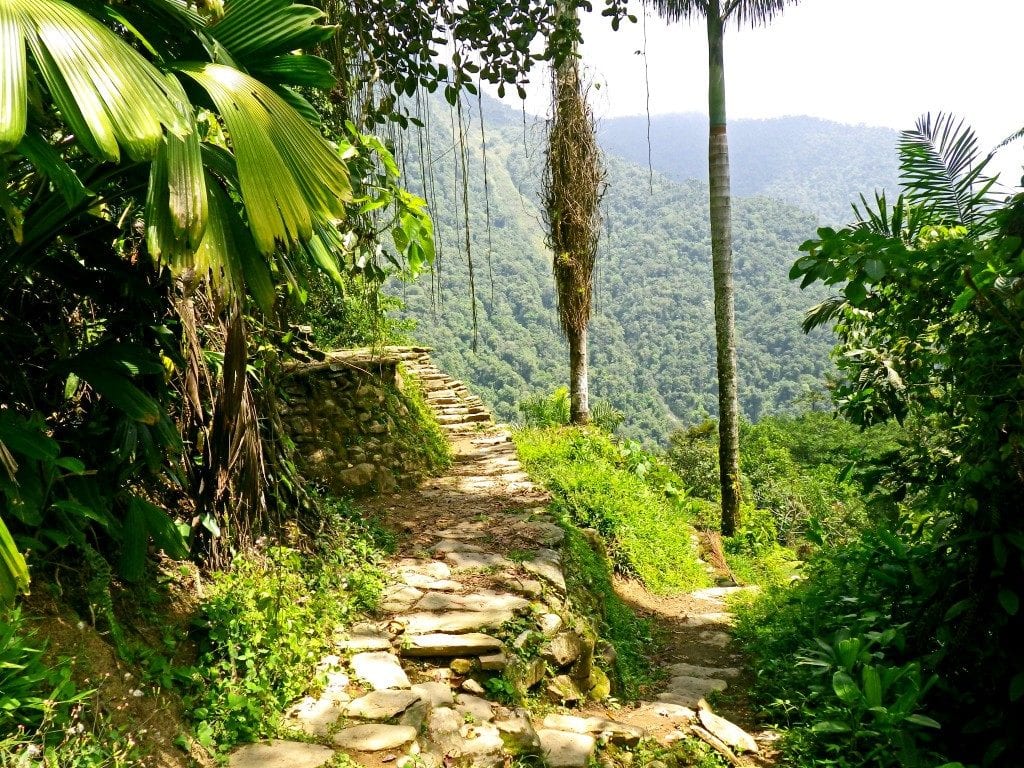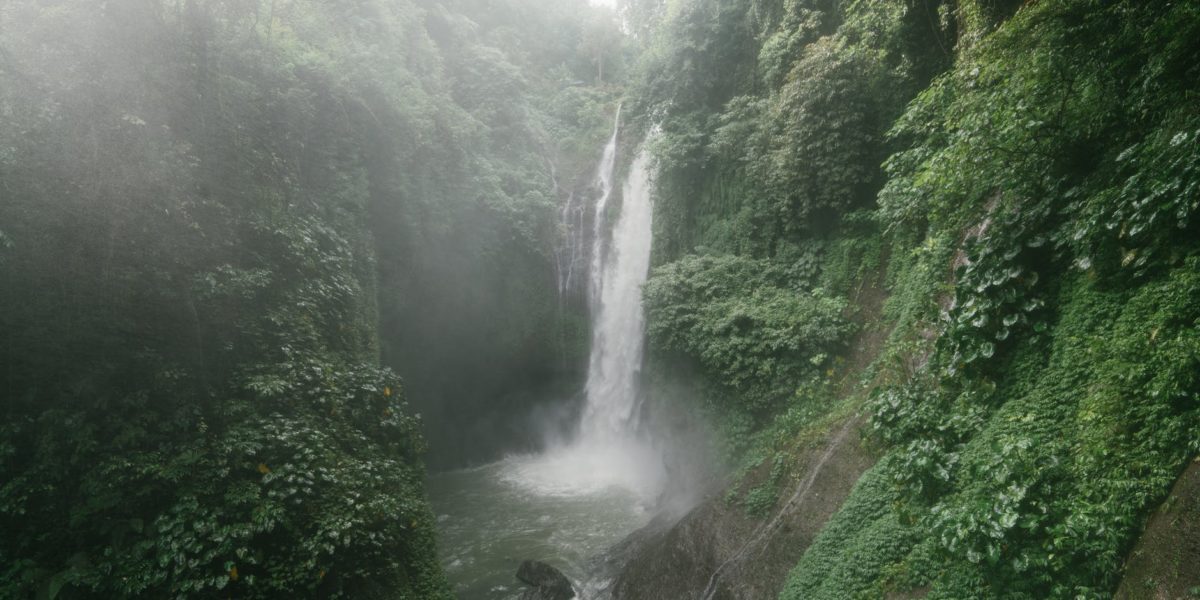Close your eyes and open your mouth,” commanded our guide
The coca leaves and calcio from the poporo are a sacred right of passage for Kogi men and used for prayer to “Pachamama” or Mother Earth. The calcio and coca leaves burn incessantly for the men as they come of age and participate in the sacred ritual for the first time, grinding down their gums and blackening their mouths. It’s a hallucinogen, especially when paired with fasting. The Kogi men don’t eat for days, praying to Pachamama and grinding their gourd with the sticks. At breakfast the next morning over papaya, eggs, and black beans prepared at a campamiento by Camacho’s family, a 20-something Frenchman asked, “Do women participate in these rituals as well?”
“Women will take no part,” Camacho laughed. “Women are married at puberty, around age 12, and kept as a wife as long as they can have children. When a woman is past her childbearing years, the man will get himself a new wife while the woman is relegated to “grandmother status.”
Suffice it to say, the modern woman is nowhere to be found in these Colombian jungles where women of “grandmother status” are relegated to household chores and child-rearing. The average lifespan for a man is remarkably high, around 80 years, while a Koji woman’s life expectancy is capped at 40 years old; almost half the life expectancy of their male counterparts.
“The homebound female incurs lung infection from smoke used to cook, for heat, and to keep mosquitoes away,” Camacho explained. “This happens while men are out revering Pachamama with coca leaves, calcio, and moonshine liquor.” These women can’t set foot in Pachamama’s worship temple, they cannot take civilization—the poporo—in their hands. The Kogi women cannot join the men as they pray and dance together; they simply are meant to be at the receiving end of sacred wisdom. The Kogi women are gatekeepers on the fringes of the Promised Land, here in Colombia.
The Kogi people are a tribe flourishing in Northern Colombia for over thousands of years, resisting Spanish conquest, maintaining their native culture and living as if untouched by time deep in the jungles of the Sierra Nevada de Santa Marta. They educate without the written word and they function without the wheel. Kogis reside in circular huts—each perfect sphere paying homage to Saranqua—the Sun God—and made of stone, mud, and hatched with palm leaves. These same huts have existed over countless generations, re-hatched every two years.
The central hut, “the house of the world,” is accessible only to men; it is there that the sacred is explored, politics are discussed, and village decisions are made. Kogis claim memory of the beginning of time and detail the rampage of Spanish conquest in their region in the 1400’s.
We—a group of 20-something hikers—were en route to the Lost City, La Cuidad Perdida, pre-Incan ruins older than Machu Picchu that remained undiscovered until 1974 by land pirates in search of gold. The Kogi Indians use these sacred grounds of their Tairona Indian ancestors for an annual convention of worship and dance, gathering Kogis from near and far.
Our 30-mile trek brought us to 1,200 crumbling stone stairs, built in 400 A.D., leading up to 32 acres of brilliant green moss-shrouded stone city, divine ordination evident in each ruin. Perfect elevated spheres tiered downward to the river as we marveled at the raw design and architectural prowess of the ancient peoples. I imagined, enviously, the Koji men meeting, dancing, and praying with their poporos. Each dark solemn face deeply concentrated in worship. The Kogi’s white, stiff canvas clothing stained in light browns over sun-caramelized skin rhythmically swaying back and forth with their brittle, greasy black hair. Kogis have an unparalleled reverence for all things nature. Pachamama is not some distant God, she is “the mind inside nature.”

As we hiked, we passed the Kogi peoples along the trails during our five days of trekking. The Kogi appeared untouched by time, solemnly wandering the trails, barefoot whilst carrying their children and poporos. As I stumbled for words to articulate the injustice faced by the Kogi women, a fellow hiker of mine interjected:
“The Kogi women are probably thrilled to start their period, get a husband, and start a family. It’s how they worship Pachamama, it’s how the generations before them—in these very lands—also worshipped Pachamama. She is given a sense of belonging. Women become part of something, so grand, so beautiful, that it would almost be irreverent for you to want to ‘rescue her.’ We have no tradition, no sense of belonging—that’s why people are lost.”
He continued after a few minutes of my silent contemplation.
“They’ll soon be married and firmly aware of their purpose in life, to know why they exist. The Kogi women belong to a community, they’ll be known and they will live out the rich traditions of their culture for thousands of years, connected to Mother Earth.”
In modern culture, we have short-term fulfillment. Hardly any tradition left. We’re lost and hiking to a Lost City, thousands of miles from our own homes and communities in one of the most dangerous countries in the world. I saw the Kogi women filling their roles—the roles their ancestors had before them—from my shallow, entitled perspective, and yet, I was still overwhelmed by the gross disparity of injustice in this remote community. Half the lifespan of men? Exclusion from spirituality? From politics? From community decisions?
“But you’re a man,” I reminded my fellow hiker. “You’ll learn and expand your mind, walking among the jungle with an infinite horizon, free to invest in the world, contemplating all of it—the physical, the spiritual—while the women’s path is paved. Paved, short, and limited.”
“Exactly! The woman’s path is paved. She knows her purpose,” he retorted. “Who are we to judge the quality over quantity? And what is remarkably different among the Kogis from our cultures? They, too, have the politics, corruption, and betrayal. People are people.” I didn’t respond.
A few miles into the hike I saw two young Kogi girls huddled in the shade of a palm. Their large black eyes stared at us strangers, studying our massive packs and neon dry-fit shirts. Their dark tousled hair, stained white dresses, colorful woven satchels, and rich dark skin emanated natural beauty beside their straw huts and the Sierra Nevada Mountain backdrop. One of the girls approached me as we slowed and she pointed from her face to mine, our gazes connecting in mutual curiosity. I broke then, imagining her time-marked future of obedience and labor—a grim fate for a young girl with her whole life ahead of her. Are guiding values, purpose, and profound spiritual satisfaction worth the intellectual limitations, the submission, the sacrifice, and the boundaries?
I would fly home to my developed world—to a place where opportunities for women are plentiful, where women can seek education and financial independence— and back there in the Colombian jungle, the Kogi women would reverently submit to their fates. Both the Kogi women and I would ultimately seek moments of joy, worth, success, satisfaction and a deeper understanding of the world around us. But I would—God willing—live beyond 40. I would live unconcerned about losing my position in family and society with age. I would pursue my passions while that little Kogi girl who pointed to her face and then mine, would sustain her family, reproduce, serve, and then die young.
The Kogi girl’s days would be a reverent adventure with the physical and spiritual depth of the vibrant tiers of flora, cascading falls, and infinite peak vistas. I would merely continue my sporadic escapes from my cubicle on weekends and holidays. I was left no clearer than when I had arrived: is it better to have tradition or progress?



this is the epitome of white feminist savior mentality. it is disgusting how little Becky does to actually get the details about the tribes traditions in order to make her wild accusations. the words of her tour guide and ‘other hiker’ completely contradict published accounts and studies, done by people who have actually spoken to the tribe. instead of treating these people like animals in a zoo, please do some basic research first. wow.
I agree
absolutely agree, go and spend some time with the Kogui and realise what women actually mean in their community. Another white woman doing a Lost City Trek thinking that is a full insight to the Kogui community and culture.
I agree. Across the planes of consciousness we have to live with the paradox that opposite things can be simultaneously true. ––Ram Dass
We don’t need to save the Kogi. They are beautiful. Our enlightened technology does not make us anymore intelligent. Do we want these perfect people to grow fat looking at cat videos all day? Stop giving them basketball sneakers, hip-hop music, and dead promises of a better future. Let them stay beautiful. The only people that we need to look at is ourselves.
This article seems very similar to the mentality of Spanish white European coloniser when they invaded their land. Spanish treat indigenous people as savages that need to be civilise erasing and wiping out their cosmogony, believes and traditions, to justify the horrible things they do to my people. No all the develop create in western countries has to be taken as true and rule.
As outsiders it is hard to know exactly what happens inside Kogi society as there are not many books written, and even those books are written by male anthropologists who are interpreting what they see based on their own perspective.. Traditional societies do tend to follow traditional roles, and men in most societies tend to look after their own interests rather than ours, unless they are more feeling men. One difference is that elder women in traditional cultures, from what I know about N American tribes,are often given more respect and are consulted by younger people. I think one would have to talk to Kogi women and ask them about their lives, but they do not seem to want Westerners to interfere with the way they choose to live for good reasons. I do wonder myself if there is some unhappiness between women when men choose a new younger wife.